With Google Ads, the conventional logic of reaching your target audience has been transformed, allowing businesses to realize unparalleled opportunities to generate income.
No matter if you’re an owner of a small enterprise or a digital marketing enthusiast, mastering Google Ads might become the key to significant revenues.
But how do you truly maximize its potential?
In this article, you’ll learn actionable strategies and tips on how best to make money with Google Ads.
With its wide reach and precise targeting capabilities, Google Ads allows marketers to connect with people in need of their services or products.
By understanding its mechanics and leveraging its features, you can turn this advertising tool into a profit-generating machine.
- Understanding Google Ads and Its Profit Potential
- How to Create Effective Google Ads Campaigns
- Maximizing Your Revenue with Advanced Google Ads Features
- Decreasing Costs by Increasing Returns
- Scaling Success: Building a Sustainable Google Ads Strategy
- Making Money with Google Ads: Key Takeaways to Success
- Commonly Asked Questions About Making Money with Google Ads
Understanding Google Ads and Its Profit Potential
Google Ads is more than just a platform for placing ads; it’s a powerful system that connects businesses with their ideal customers.
To really make money with Google Ads, you have to understand how it works and what opportunities it offers.
At its core, Google Ads operates on a pay-per-clickAn advertising model where advertisers pay only when their ad is clicked. (PPC) model.
You pay for every click your ad receives; therefore, creating campaigns that provide value and attract the right audience is essential.
By carefully managing your campaigns, you can maximize your return on investment (ROIReturn on Investment, a measure of the profitability of an investment.) and ensure profitability.

A visualization of how Google Ads functions, depicting a search engine interface and the analysis of ad performance.
What Is Google Ads and How Does It Work?
Google Ads allows you to bid on specific keywords that potential customers search for on Google.
When someone searches for those keywords, your ad has the chance to appear at the top of the search results.
This ensures high visibility and increases the likelihood of clicks.
- Pay-Per-Click Model: You only pay when someone clicks on your ad, making it a cost-effective advertising method when managed well.
- Customizable Campaigns: Google Ads offers various campaign types, including search, display, video, and shopping ads, to cater to different business goals.
- Advanced Targeting: Features like location targeting, audience segmentation, and device preferences help you reach the right audience effectively.

An illustration showcasing the profitability and benefits of Google Ads, emphasizing its role in income generation.
The Benefits of Using Google Ads for Income Generation
Google Ads is a versatile tool that offers multiple ways to generate income.
From driving direct sales to increasing website traffic and building brand awareness, its benefits are numerous.
- Immediate Results: Unlike organic marketing strategies, Google Ads delivers quick results, helping you achieve your business objectives faster.
- Scalable Opportunities: Whether you’re a small business or a large corporation, Google Ads provides scalable options to suit your budget and goals.
- Data-Driven Decisions: Detailed analytics and reports allow you to measure your performance and make informed adjustments to optimize your campaigns.
Google Ads operates on a pay-per-click model, which means you pay only for actual engagement, providing an opportunity to optimize ROI effectively.

An illustration of the strategic process of creating effective Google Ads campaigns, emphasizing planning and optimization.
How to Create Effective Google Ads Campaigns
Creating an effective Google Ads campaign requires planning, precision targeting, and continuous optimization.
To make money with Google Ads, it’s essential to understand the details of creating and managing campaigns.
By following best practices, you can maximize your returns and minimize wasted ad spend.
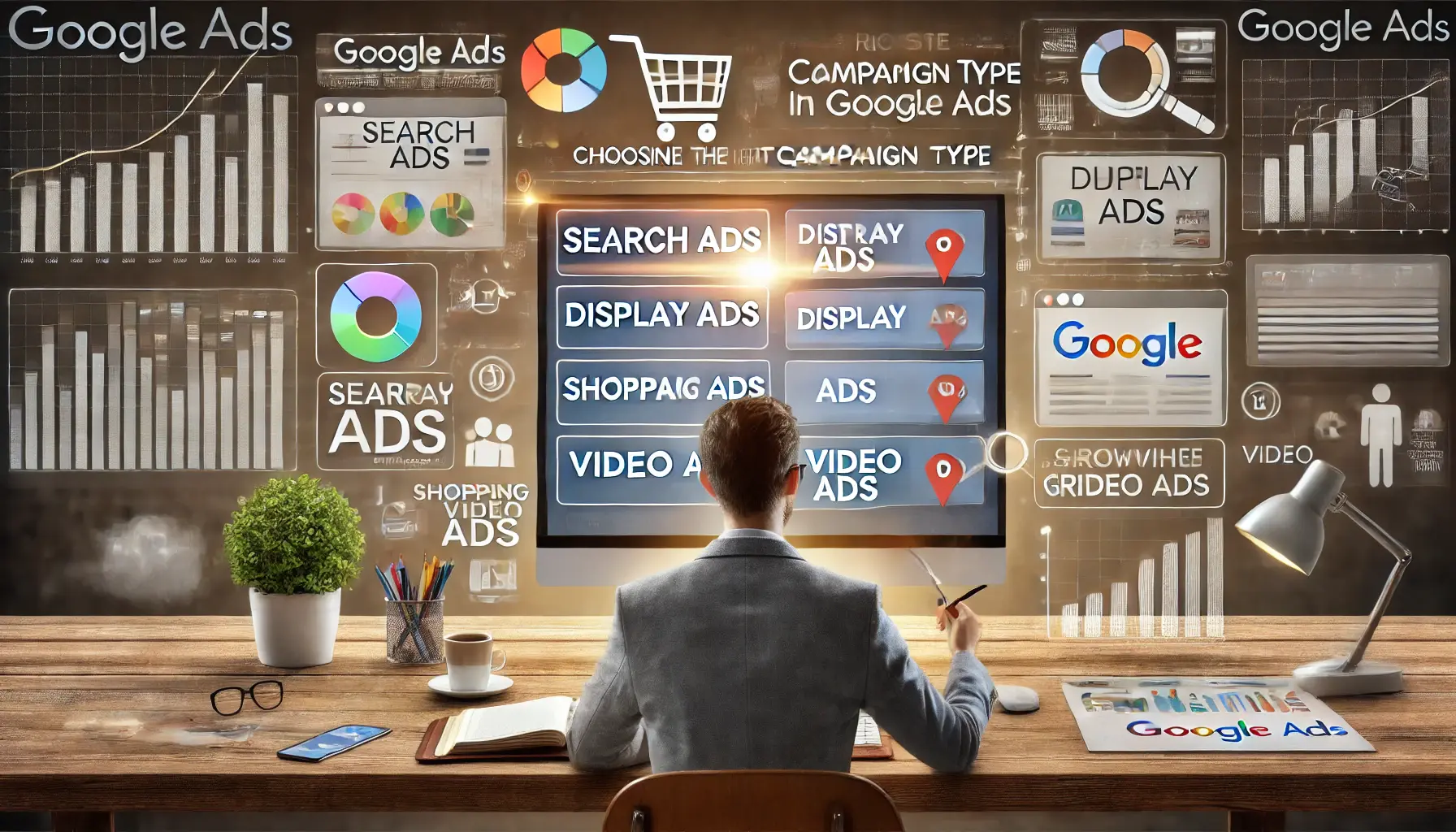
An illustration of the decision-making process for selecting the right Google Ads campaign type to achieve specific goals.
Choosing the Right Campaign Type for Your Goals
Google Ads offers several campaign types, each suited to different business objectives.
Selecting the appropriate type is the first step to crafting an effective strategy:
- Search Campaigns: Ideal for businesses looking to drive traffic to their website by targeting users searching for specific keywords.
- Display Campaigns: Perfect for increasing brand awareness with visually engaging ads across Google’s Display Network.
- Shopping Campaigns: Tailored for e-commerce businesses to showcase products directly in search results.
- Video Campaigns: Great for promoting video content on YouTube and Google’s video partners.
- App Campaigns: Designed to drive app downloads and engagement through targeted ads.

An illustration showcasing the critical role of keyword research in Google Ads for optimizing ad performance.
The Importance of Keyword Research in Google Ads
Keyword research is the backbone of a successful Google Ads campaign.
It ensures that your ads reach users actively looking for products or services similar to yours.
Here’s how to conduct effective keyword research:
- Use tools like Google Keyword Planner to identify high-volume, low-competition keywords.
- Focus on long-tail keywords to capture specific user intent and reduce costs.
- Analyze competitor keywords to discover opportunities.
- Regularly update your keyword list based on performance data.
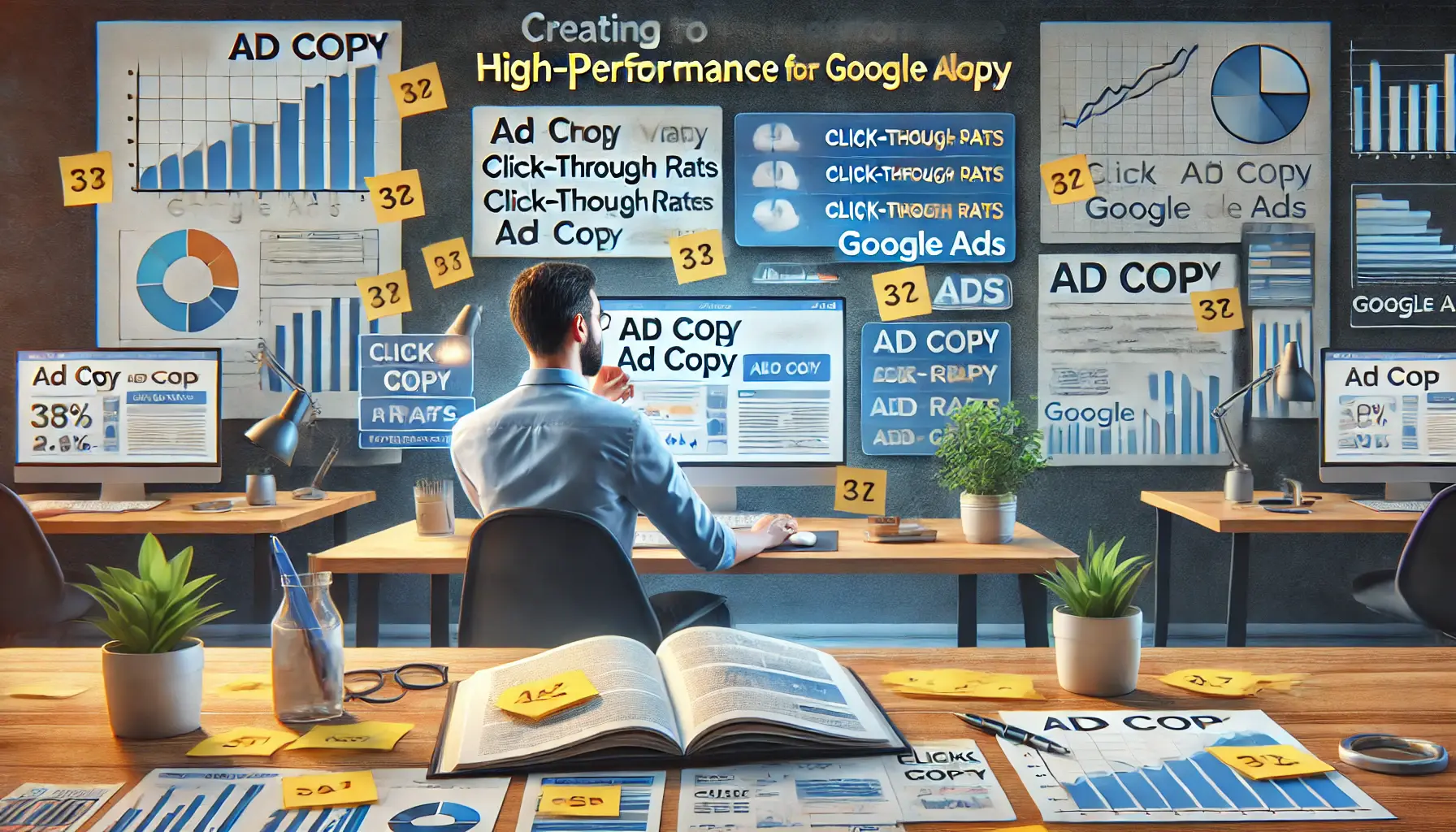
An illustration of the creative process behind developing high-performance ad copy for Google Ads.
Creating High-Performance Ad Copy
Ad copy plays a crucial role in attracting clicks and converting users.
A well-crafted ad not only grabs attention but also communicates value:
- Headline: Make it compelling and keyword-rich to capture user interest.
- Description: Highlight unique selling points and include a strong call-to-action (CTA).
- URL: Use a clear and relevant display URL that matches user expectations.
Test multiple variations of your ad copy to determine what resonates best with your audience.
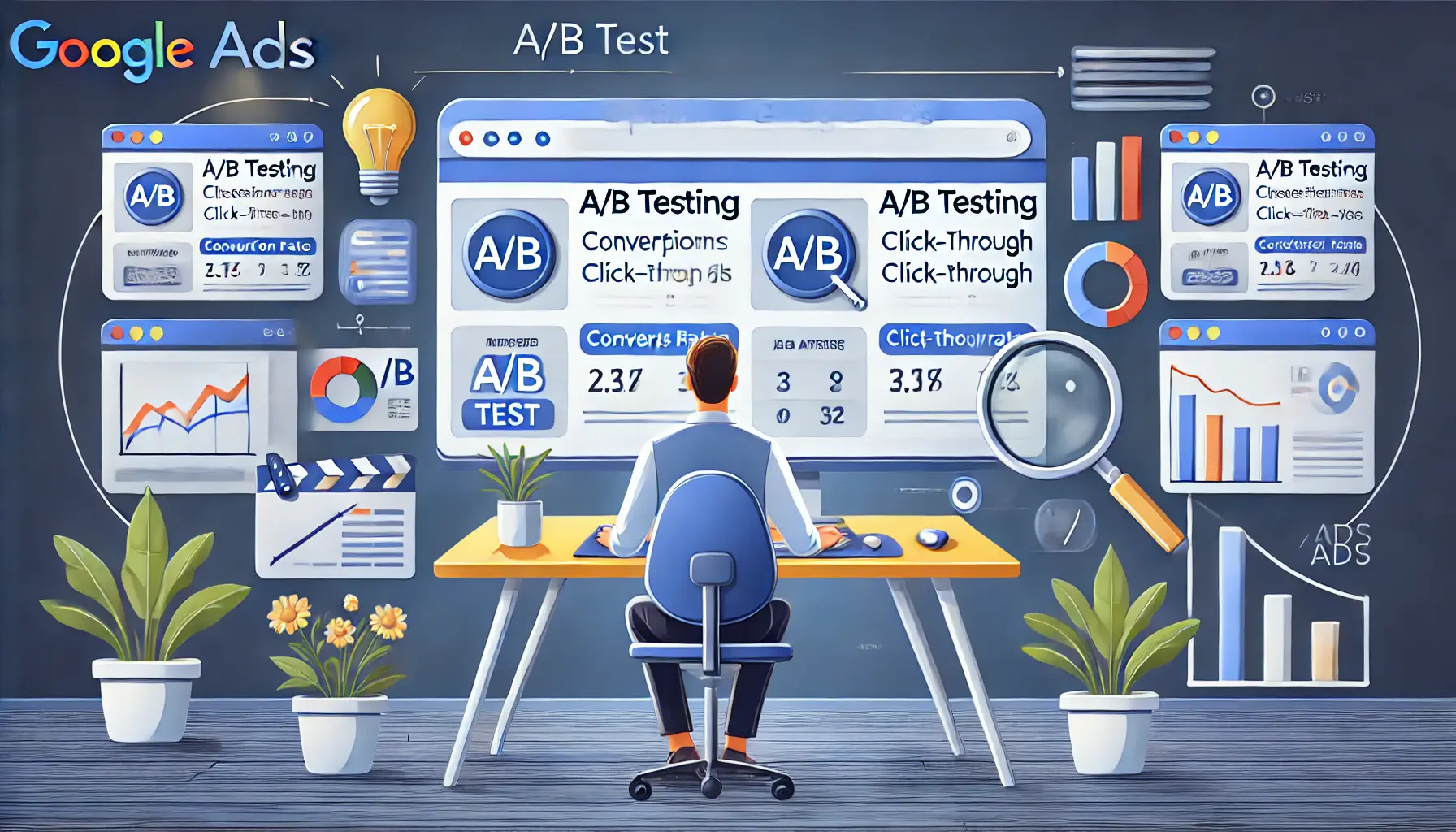
An illustration of the A/B testing process to optimize Google Ads campaigns, focusing on data analysis and ad performance comparisons.
Using A/B Testing to Optimize Campaigns
A/B testing allows you to compare different versions of your ads to identify which performs better.
This iterative process of testing and optimization involves trying different combinations of headlines, descriptions, and CTAs.
Additionally, experiment with targeting options and bid strategies to achieve optimal performance.
- Monitor key performance metrics like click-through rate (CTR), conversion rate, and cost-per-click (CPC).
- Implement the winning variations to maximize results.
- Combine A/B testing with ongoing refinement for effective Google Ads campaigns that yield maximum profitability.
Creating effective campaigns requires understanding your audience, using targeted keywords, and continuously monitoring performance to make data-driven improvements.

An illustration of using advanced Google Ads features like smart bidding and ad extensions to maximize revenue.
Maximizing Your Revenue with Advanced Google Ads Features
To really make money with Google Ads, it does not suffice to create basic campaigns.
Advanced features will bring in the best revenue by targeting the right audience, optimizing bids, and enhancing your ad performance.
Understanding these tools and using them strategically is key to taking your campaigns to the next level.
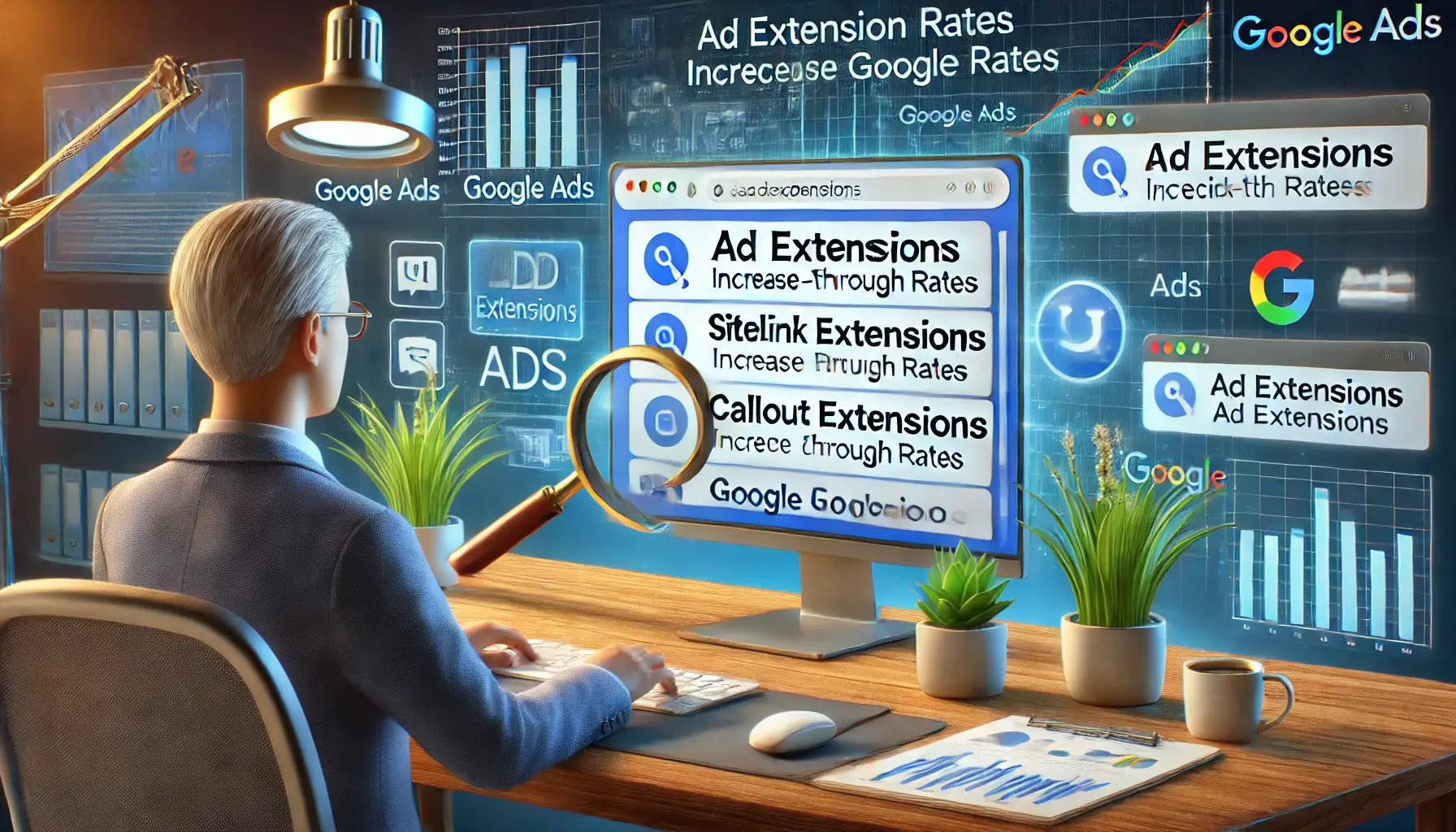
An illustration of using ad extensions like sitelinks and callouts to improve click-through rates in Google Ads.
Leveraging Ad Extensions for Higher Click-Through Rates
Ad extensions are powerful tools that can improve your ad’s visibility and increase click-through rates (CTRClick-Through Rate, a metric that measures the percentage of clicks an ad receives relative to its impressions.).
They allow you to provide additional information that makes your ad more appealing:
- Sitelink Extensions: Highlight specific pages on your website, such as product categories or promotions.
- Callout Extensions: Showcase unique selling points like free shipping or 24/7 customer support.
- Call Extensions: Enable users to call your business directly from the ad.
- Structured Snippets: Provide extra details about your offerings, such as types of services or product features.
By utilizing these extensions, your ads become more engaging, increasing the likelihood of clicks and conversions.

An illustration of smart bidding in Google Ads, showing automated bidding strategies and performance data analysis.
Understanding and Utilizing Smart Bidding
Smart Bidding is a set of automated bid strategies powered by machine learning.
It helps optimize your bids in real-time to achieve your desired goals:
- Target CPA (Cost-Per-Acquisition): Automatically adjusts bids to get as many conversions as possible within your target cost-per-acquisition.
- Target ROAS (Return-On-Ad-Spend): Focuses on maximizing revenue based on your return-on-ad-spend goals.
- Maximize Conversions: Aims to generate the highest number of conversions within your budget.
- Enhanced CPC (Cost-Per-Click): Adjusts your manual bids to improve conversion outcomes.
These strategies reduce the manual effort required for bid adjustments and help you achieve better results more efficiently.
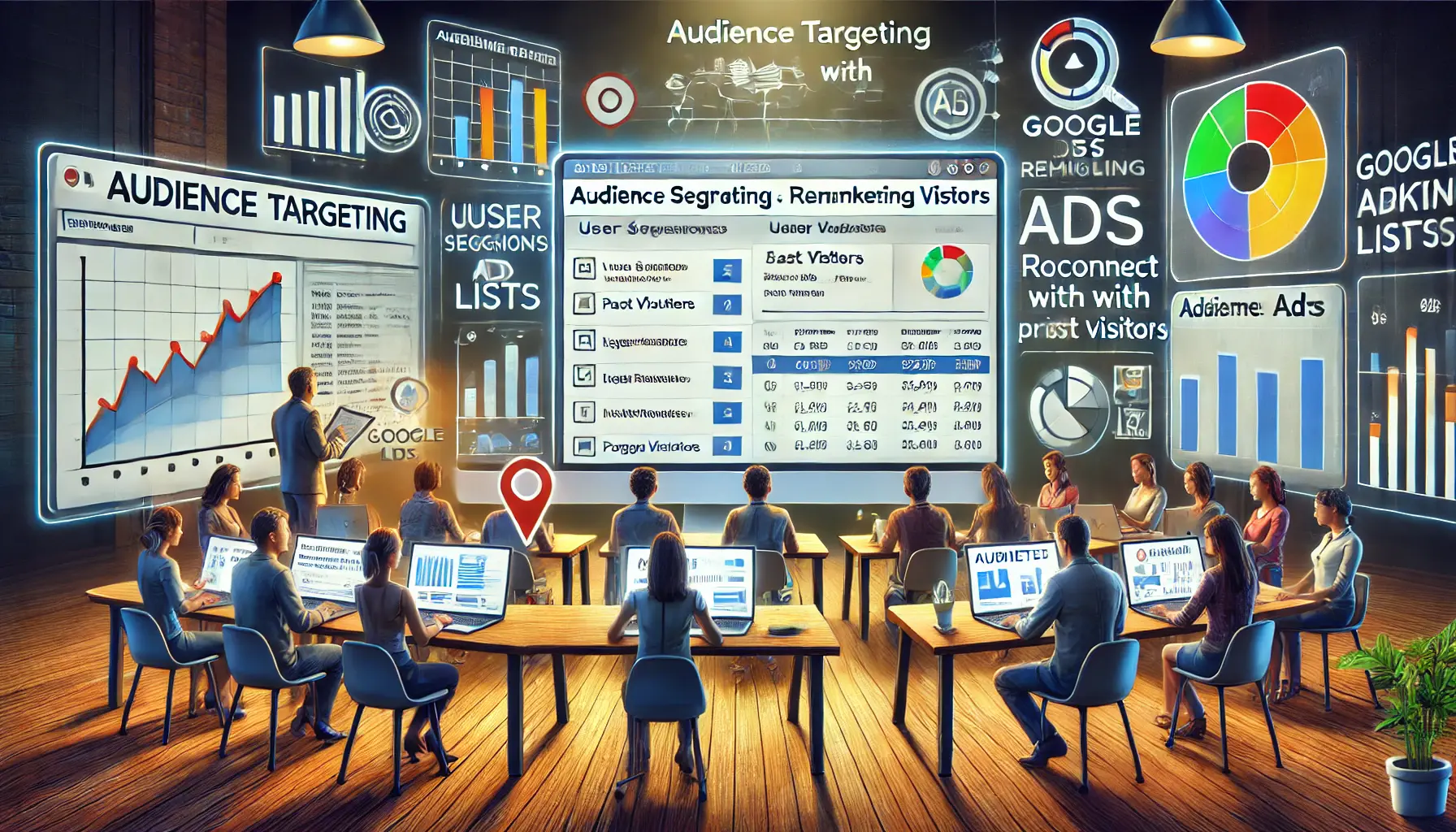
An illustration of audience targeting through Google Ads remarketing, focusing on reconnecting with previous visitors.
Targeting Audiences with Google Ads Remarketing
Remarketing allows you to reconnect with users who have previously interacted with your website or app.
This feature is highly effective for driving conversions and increasing revenue:
- Create remarketing lists based on user behavior, such as pages visited or actions taken.
- Show tailored ads to these users across Google’s Display Network and Search Network.
- Use dynamic remarketing to display ads featuring products or services users viewed on your site.
Remarketing keeps your brand top-of-mind and encourages users to complete their purchase journey.
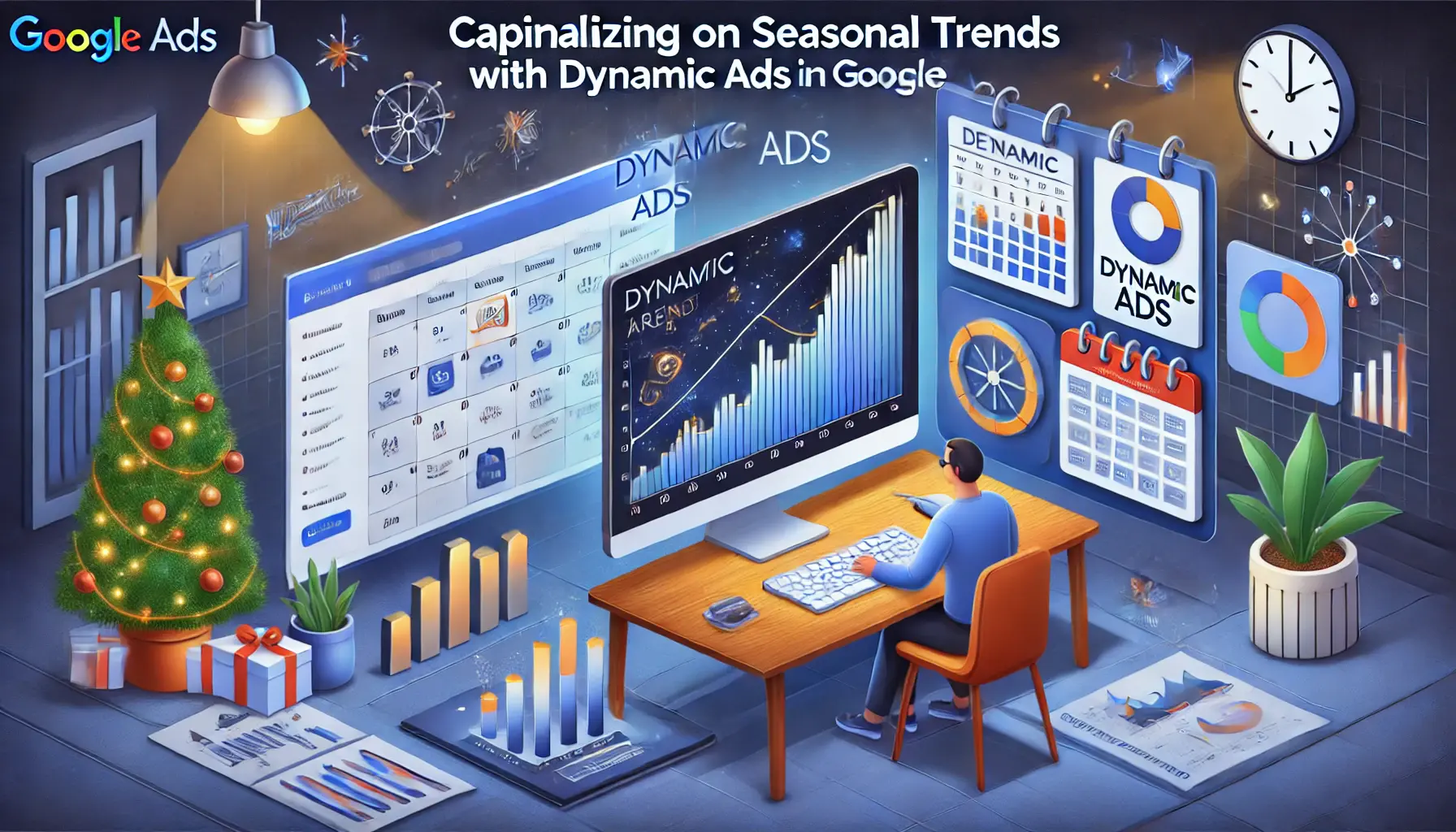
An illustration of using dynamic ads to capitalize on seasonal trends in Google Ads, highlighting festive promotions and product targeting.
Capitalizing on Seasonal Trends with Dynamic Ads
Dynamic ads automatically adjust content based on user behavior and seasonal trends, making them an excellent choice for maximizing revenue during peak times:
- Use dynamic search ads to match user queries with relevant content on your site.
- Create dynamic remarketing ads that showcase products users viewed or added to their cart.
- Optimize dynamic ads for seasonal promotions and limited-time offers.
These ads help you stay relevant and capitalize on opportunities to boost sales during key periods.
By incorporating these advanced features into your Google Ads strategy, you can significantly enhance your campaigns, drive more conversions, and maximize revenue effectively.
- Utilize ad extensions like sitelinks and callout extensions to enhance visibility and CTR.
- Leverage smart bidding to automate bid adjustments and achieve desired goals.
- Implement remarketing strategies to reconnect with engaged users and drive conversions.

An illustration of optimizing ad campaigns by decreasing costs and increasing returns, focusing on maximizing ROI in Google Ads.
Decreasing Costs by Increasing Returns
Making money with Google Ads isn’t just about raking in the revenue; it’s equally about managing your expenses effectively.
By lowering the waste of your ad budget and further optimizing your campaigns, you can increase ROI without sacrificing— and maybe even increasing—conversions.
Here’s how to achieve cost efficiency without compromising on results.

An illustration of a digital marketer working to avoid common pitfalls in Google Ads management by optimizing ad campaigns.
Avoiding Common Pitfalls in Google Ads Management
Many advertisers unknowingly waste money on ineffective strategies or mismanaged campaigns.
Avoid these common mistakes to ensure your budget is used effectively:
- Ignoring Negative Keywords: Failing to use negative keywords can lead to irrelevant clicks that drain your budget.
- Poor Ad Scheduling: Running ads during off-hours or low-performing times can result in wasted spend.
- Overlooking Geotargeting: Showing ads to users outside your target region can lead to unnecessary costs.
- Not Monitoring Performance Regularly: Without frequent analysis, underperforming campaigns can continue to waste budget.
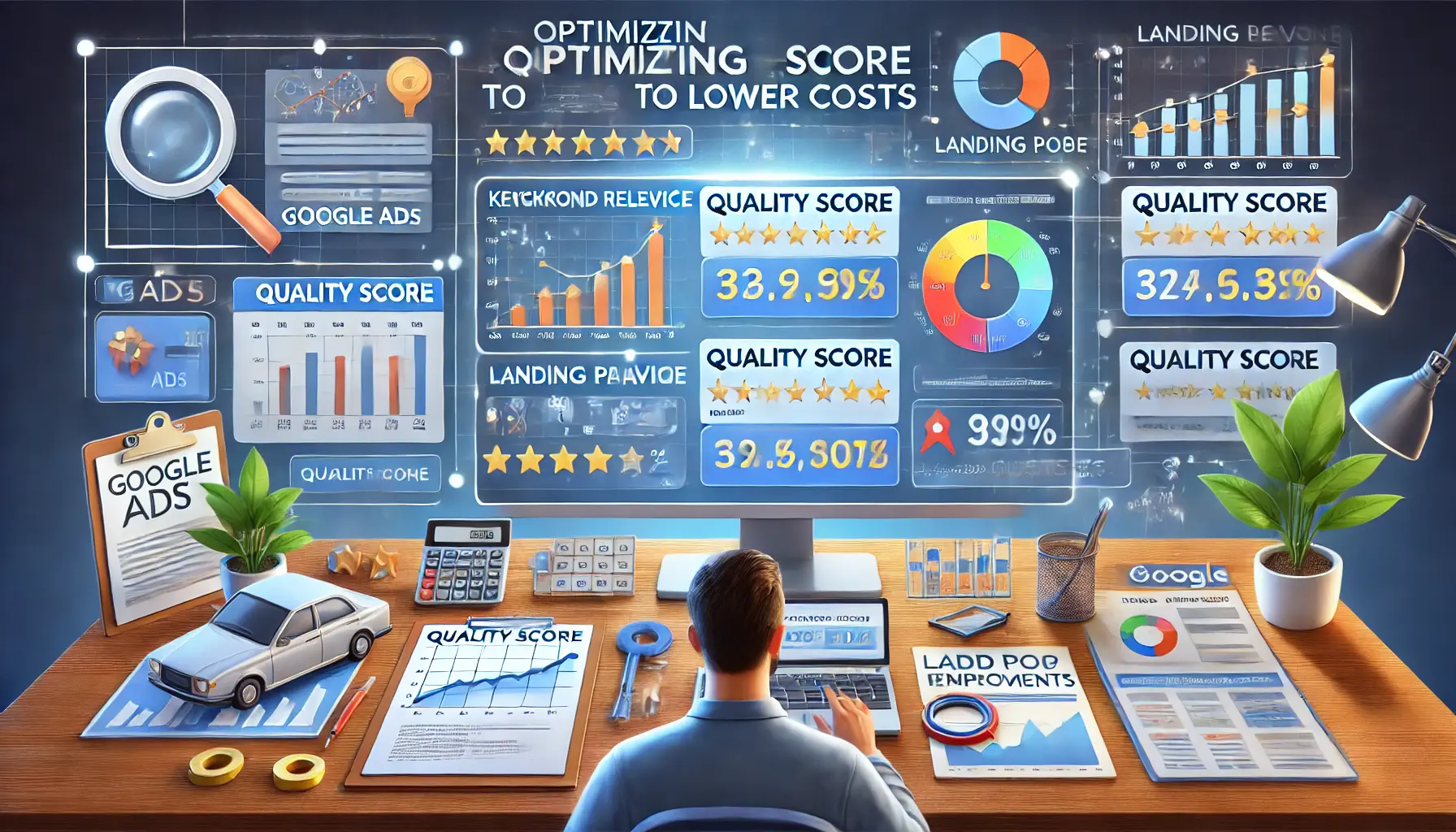
An illustration of optimizing Quality Score in Google Ads to lower costs, focusing on keyword relevance and ad performance.
Optimizing Quality Score to Lower Costs
Google Ads rewards high-quality ads with better ad placements and lower costs.
Improving your Quality Score is a critical strategy for reducing expenses:
- Focus on Relevance: Ensure your keywords, ad copy, and landing pages align closely with user intent.
- Enhance Landing Pages: Create fast-loading, user-friendly landing pages with relevant content.
- Maintain High CTR: Optimize your ad copy to encourage clicks, boosting your Quality Score over time.

An illustration of using geotargeting in Google Ads to optimize ad spend by targeting specific geographic regions.
Geotargeting for Efficient Ad Spend
Geotargeting allows you to focus your ad budget on specific locations where your audience is most likely to convert.
Here’s how to use geotargetingA method of targeting ads to specific geographic locations. effectively:
- Identify high-performing regions using Google Ads location data.
- Exclude locations with low engagement or conversions.
- Customize ad copy and offers for local audiences to improve relevance and performance.
An illustration of tracking and optimizing ad spend to reduce waste and improve performance in Google Ads campaigns.
Tracking and Reducing Wasted Ad Spend
Analyzing your ad spend is essential for identifying areas where you can cut costs.
Here are some effective strategies:
- Set Clear Goals: Establish clear objectives for every campaign to measure the ROI of your efforts.
- Monitor Search Terms: Regularly review search term reports and exclude irrelevant queries by adding negative keywords.
- Adjust Bids: Lower the bids on underperforming keywords while increasing the bids on high-converting ones.
- Refine Audience Targeting: Apply granular audience segmentation to target users who are more likely to convert.
By implementing these strategies, you can cut down your Google Ads costs while maintaining or even enhancing the performance of your campaigns, ensuring value for every dollar spent.
- Regularly review search term reports to exclude irrelevant queries.
- Optimize Quality Scores by ensuring relevance in ads and landing pages.
- Employ geotargeting to focus on high-performing regions and save costs.

An illustration of scaling success and creating a sustainable Google Ads strategy, focusing on growth and strategic planning.
Scaling Success: Building a Sustainable Google Ads Strategy
Once you’ve mastered the basics of Google Ads and started generating consistent results, the next step is to scale your efforts and build a sustainable strategy for long-term success.
Scaling doesn’t just mean increasing your budget—it requires a thoughtful approach to expanding your reach, refining your campaigns, and leveraging data to drive smarter decisions.
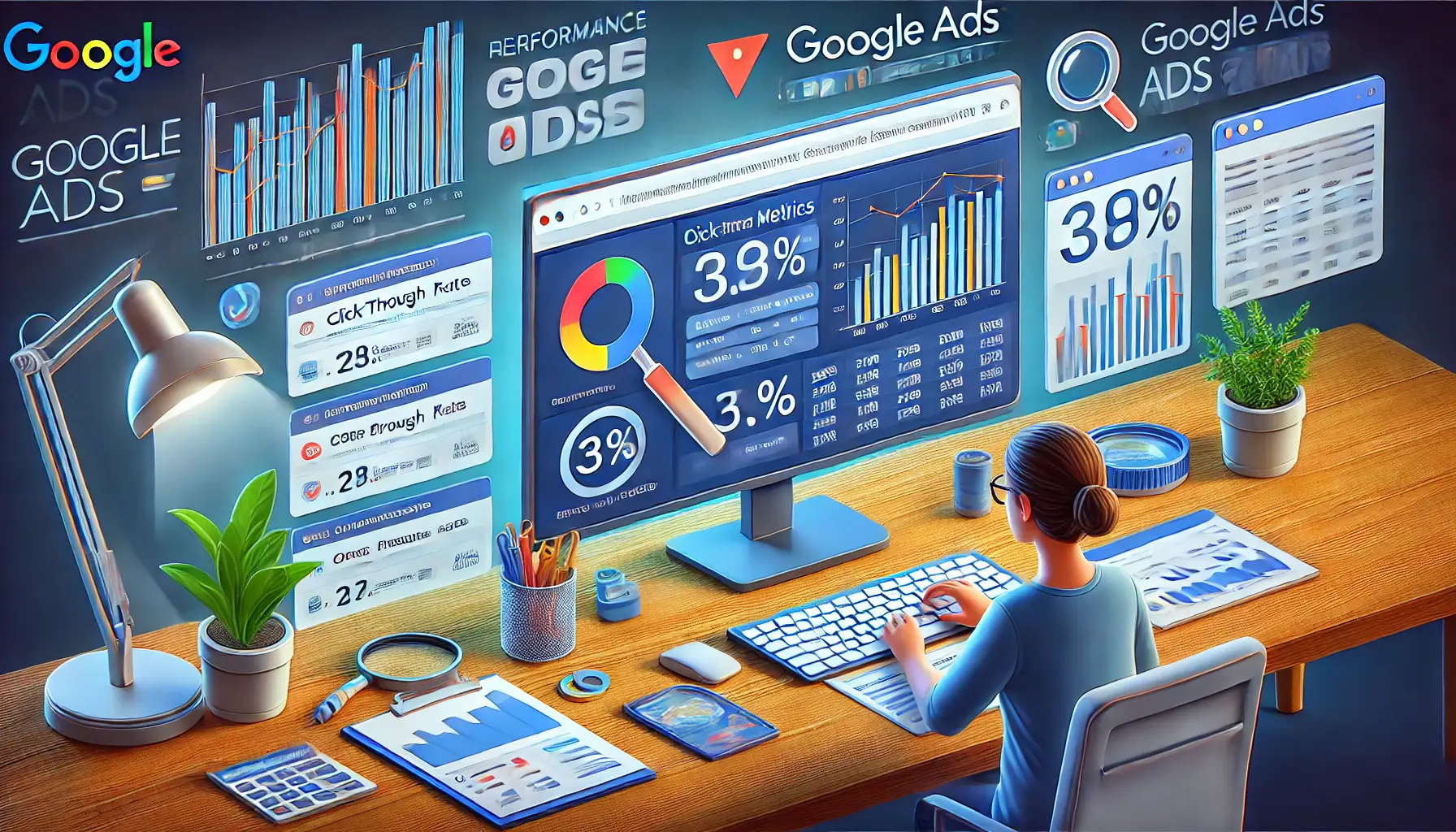
An illustration of analyzing data to optimize and refine future Google Ads campaigns based on past performance.
Analyzing Data to Refine Future Campaigns
Data analysis is critical for identifying what’s working and where improvements can be made.
Use the following methods to refine your campaigns:
- Track Key Performance Indicators (KPIs): Monitor metrics such as click-through rate (CTR), conversion rate, and return on ad spend (ROAS).
- Use A/B Testing Results: Apply insights from testing ad copy, visuals, and targeting to improve future campaigns.
- Leverage Google Analytics: Integrate Google Analytics with your campaigns to gain deeper insights into user behavior and conversion paths.

An illustration of integrating Google Ads with other marketing channels like email marketing, social media, and content marketing for a cohesive strategy.
Integrating Google Ads with Other Marketing Channels
A sustainable strategy goes beyond relying solely on Google Ads.
Integrate your campaigns with other marketing efforts to create a cohesive and effective approach:
- Email Marketing: Retarget users who interacted with your ads through personalized email campaigns.
- Social Media: Use platforms like Facebook and Instagram to reinforce your messaging and reach new audiences.
- Content Marketing: Drive traffic to valuable content that aligns with your ads, improving engagement and building trust.
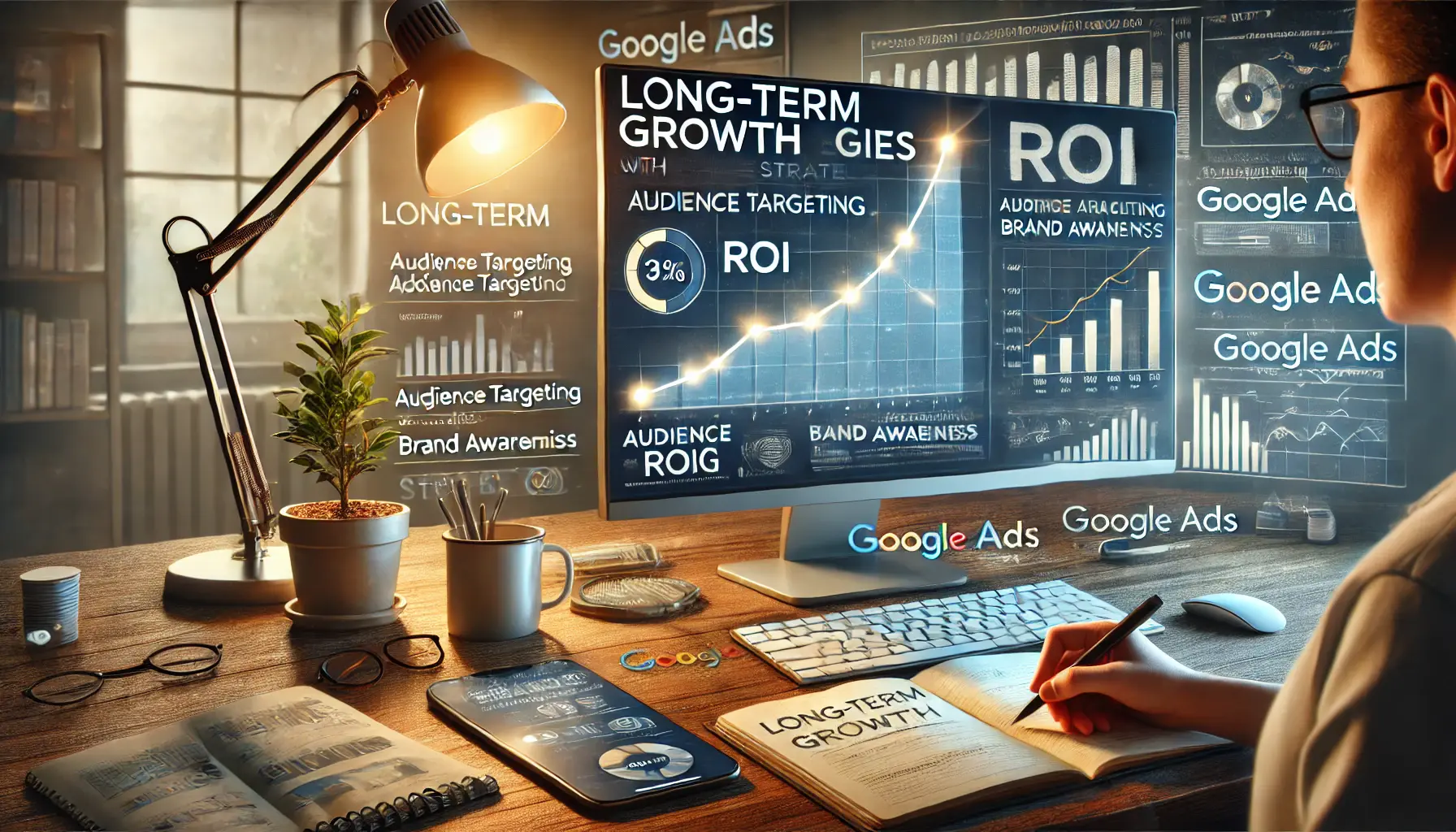
An illustration of strategies for long-term growth with Google Ads, focusing on sustainable optimization and brand awareness.
Strategies for Long-Term Growth with Google Ads
Building a sustainable Google Ads strategy requires planning for the future while maintaining consistent performance:
- Focus on Lifetime Value (LTV): Prioritize campaigns that attract high-value, long-term customers.
- Invest in Brand Awareness: Allocate budget to campaigns that enhance brand recognition, ensuring future growth.
- Experiment with New Features: Stay updated on Google Ads innovations, such as Performance Max campaigns or new targeting options.

An illustration of businesses thriving through Google Ads, with case studies showcasing the success of campaigns.
Case Studies: Businesses Thriving with Google Ads
Learn from successful businesses that have scaled their Google Ads campaigns effectively:
- E-commerce Growth: Companies that used Shopping campaigns and remarketing to drive significant online sales growth.
- Local Businesses: Small businesses leveraging geotargeting and local service ads to attract nearby customers.
- Global Expansion: Brands scaling internationally by using Google Ads’ multilingual and location-targeting features.
By taking a strategic approach to scaling your Google Ads efforts, you can ensure sustainable growth and long-term success while maximizing your returns.
Sustainable growth involves analyzing data, integrating campaigns with other marketing channels, and experimenting with new features like Performance MaxA Google Ads campaign type that uses automation to optimize across multiple platforms. campaigns for continuous improvement.
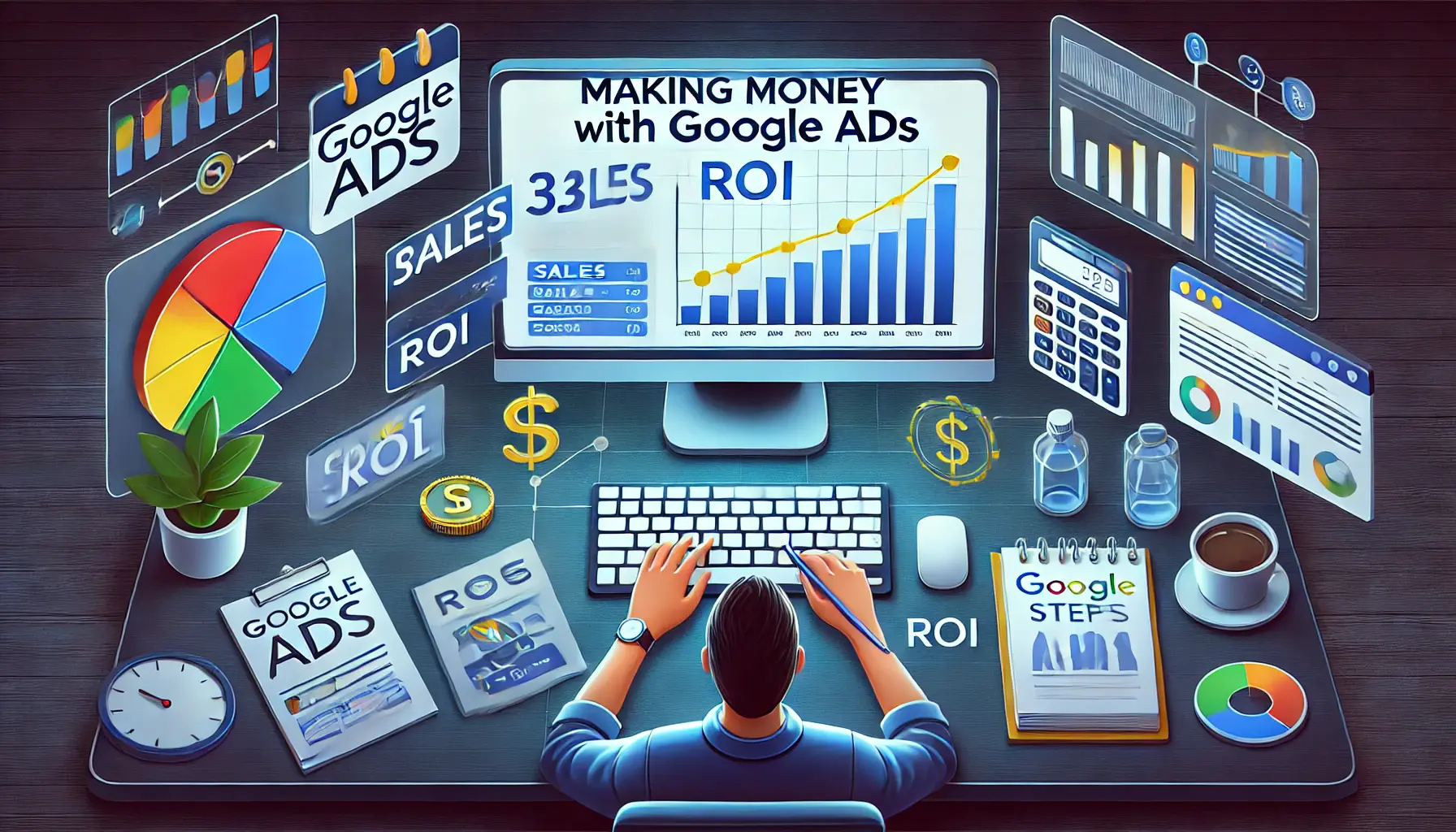
An illustration of the key strategies for making money with Google Ads, focusing on optimizing campaigns for success.
Making Money with Google Ads: Key Takeaways to Success
In this article, we explored how to effectively make money with Google Ads by harnessing its functionalities, creating strategic campaigns, and implementing optimizations for long-term success.
Whether you are just getting started or scaling your campaigns, these insights and strategies will help you maximize revenue while controlling the cost of your ad spend.
Let’s recap the key points that can guide your journey to Google Ads success.

An illustration of understanding the fundamentals of Google Ads, focusing on core components like keywords, ad copy, and bidding strategies.
Understanding the Fundamentals
At the heart of making money with Google Ads lies a clear understanding of its core mechanics.
By selecting the right campaign type, performing in-depth keyword research, and creating high-performing ad copy, you set a strong foundation for your campaigns.
Remember to monitor key metrics like click-through rates (CTR) and conversion rates to ensure your efforts align with your objectives.
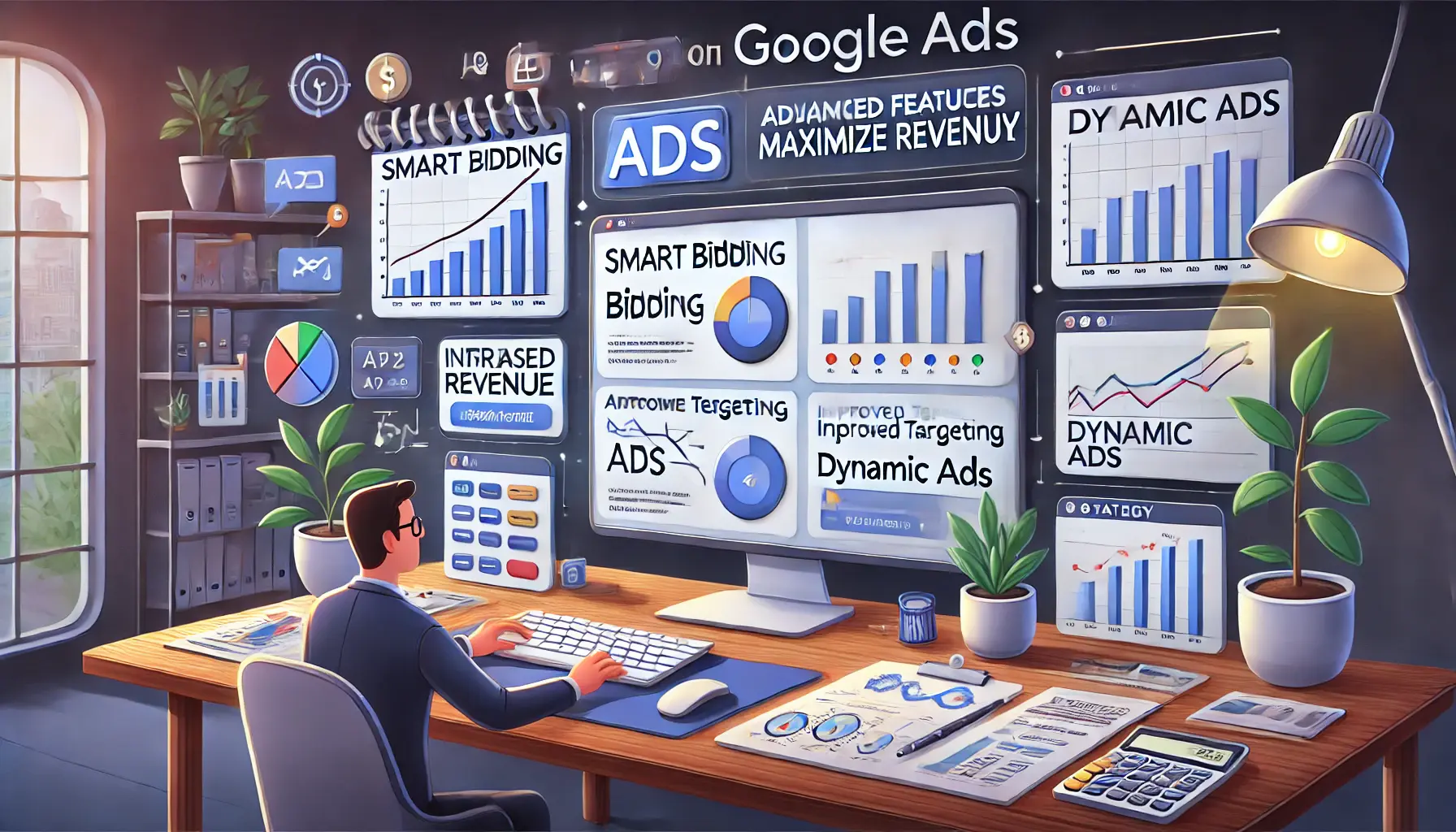
An illustration of using advanced Google Ads features like smart bidding and ad extensions to maximize revenue and improve ad performance.
Maximizing Revenue with Advanced Features
Advanced tools such as ad extensions, smart bidding, and remarketingA strategy that targets users who have previously interacted with a website or app. can significantly enhance your campaigns.
These features allow you to target specific audiences effectively, optimize bids dynamically, and stay top-of-mind with potential customers.
Incorporating these strategies into your campaigns ensures higher engagement and better returns on your investment.
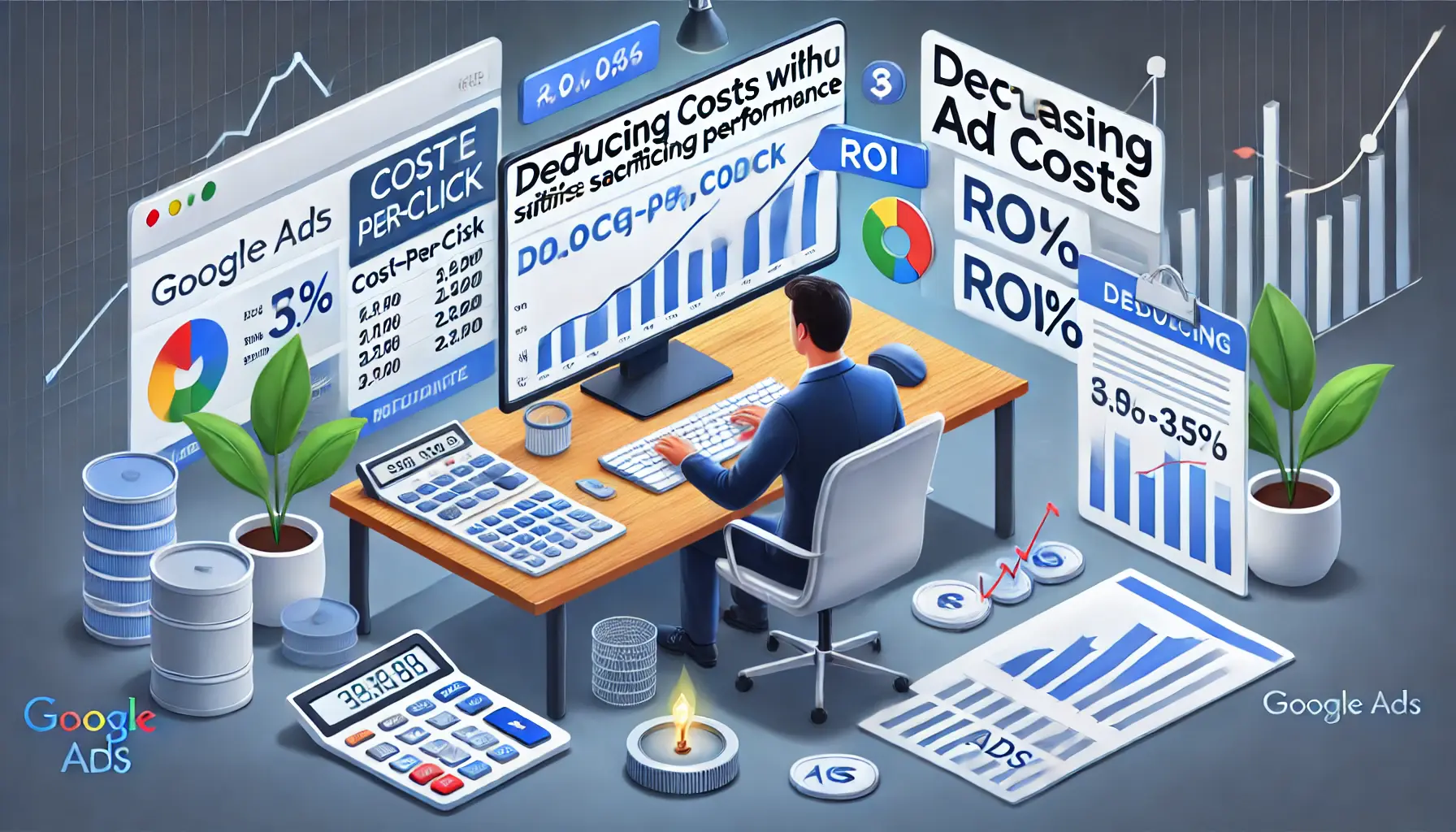
An illustration of optimizing Google Ads to reduce costs while maintaining or improving performance, focusing on efficiency and strategic adjustments.
Reducing Costs Without Sacrificing Performance
Controlling costs is just as important as driving revenue.
By utilizing negative keywordsKeywords used in Google Ads to prevent ads from appearing for irrelevant searches., optimizing your Quality Score, and employing geotargeting, you can minimize wasted ad spend.
Regularly reviewing performance data and refining your targeting ensure that your budget is allocated efficiently, maximizing the value of every dollar spent.
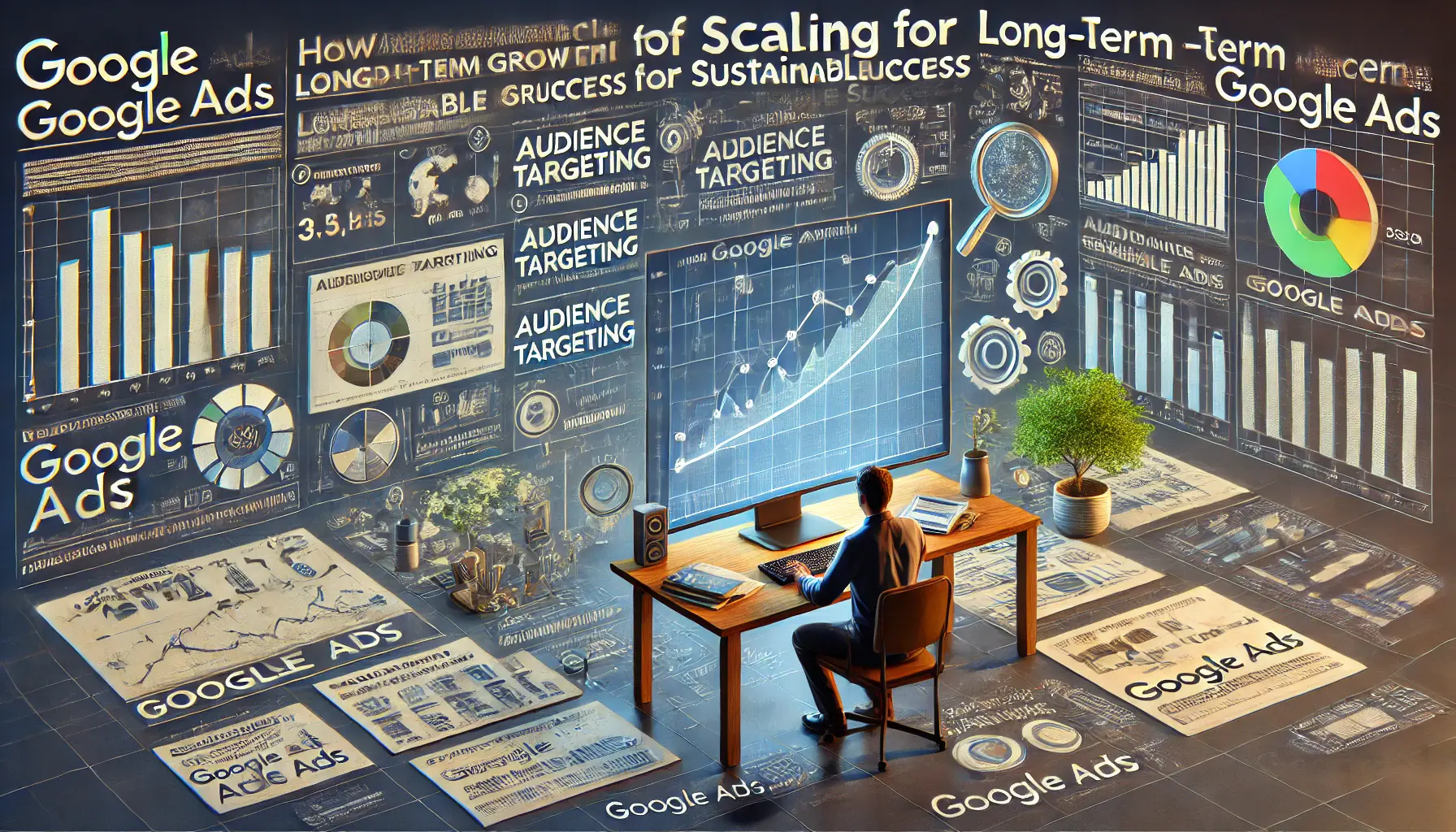
An illustration of scaling Google Ads for sustainable, long-term success with a focus on growth strategies and performance optimization.
Scaling for Sustainable Success
Building a sustainable strategy involves scaling thoughtfully, not just increasing budgets.
Use data-driven insights to refine future campaigns, integrate your Google Ads efforts with other marketing channels, and focus on long-term growth by enhancing brand awareness.
Case studies of successful businesses show that scaling with purpose leads to lasting results.

An illustration of the journey to success with Google Ads, emphasizing campaign optimization, performance data, and strategic planning.
Your Path to Google Ads Success
Making money with Google Ads is a dynamic process that combines creativity, data analysis, and strategic planning.
By applying the strategies discussed, you can build impactful campaigns that deliver consistent results.
Continue to learn, implement new features, and ride the waves of trends to ensure your success in the ever-changing landscape of digital advertising.
- Master Google Ads fundamentals to create impactful campaigns.
- Utilize advanced tools like smart bidding and remarketing to maximize revenue.
- Minimize ad spend by employing cost-efficient strategies such as using negative keywords.
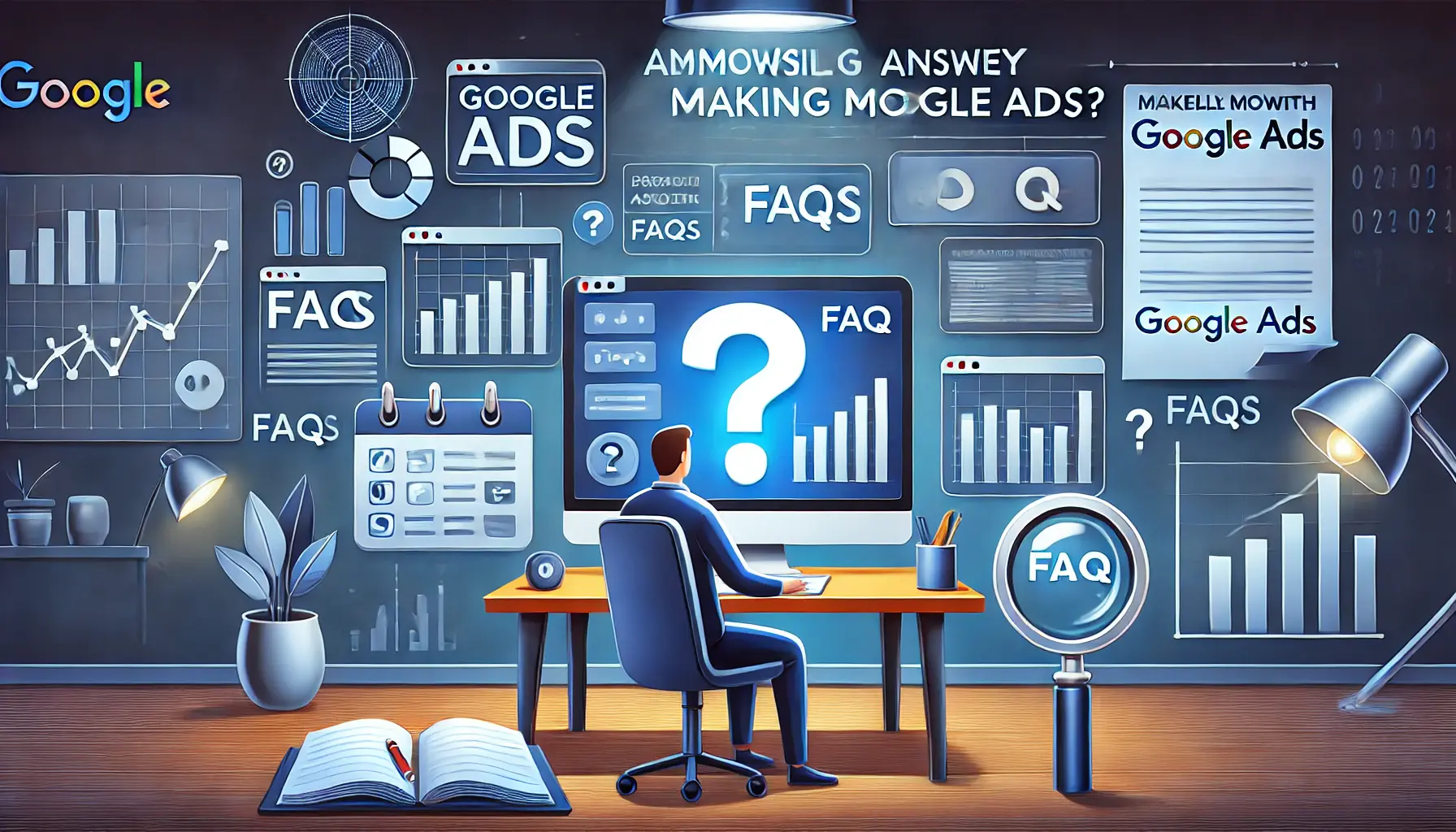
An illustration of addressing commonly asked questions about making money with Google Ads, emphasizing analysis and strategy.
Your campaigns can be managed by an agency specialized in Google Ads, check out our service page.
Commonly Asked Questions About Making Money with Google Ads
Here are answers to some of the most frequently asked questions about how to use Google Ads effectively to raise revenue and build a sustainable strategy.
Start with an objective in mind, do keyword research, and select the appropriate campaign type.
Create compelling ad copy and monitor performance metrics to optimize your campaigns for success.
Your budget depends on your business goals and industry.
Start small, monitor ROI, and gradually scale your investment as you identify what works best for your audience.
Negative keywords prevent your ads from showing for irrelevant searches, saving money and improving targeting.
Use them to eliminate unqualified traffic and focus on high-intent audiences.
Focus on relevance by aligning keywords, ad copy, and landing pages with user intent.
Improve ad performance through high CTR and optimize your landing pages for better user experience.
Yes, Google Ads can be highly effective for small businesses.
Use geotargeting, specific keywords, and controlled budgets to reach your target audience and drive local engagement.
Remarketing allows you to reconnect with users who previously interacted with your site.
It boosts conversions by keeping your brand top-of-mind and targeting interested customers.
Use Google Ads’ dashboard and tools like Google Analytics to monitor CTR, conversion rates, ROAS, and other KPIs.
Regular analysis helps refine and optimize campaigns effectively.
Review campaigns weekly to ensure they perform well and remain cost-effective.
Regular checks help identify trends, optimize strategies, and make necessary adjustments promptly.
Smart bidding uses machine learning to optimize bids for conversions or value.
Strategies include Target CPA, Target ROASReturn on Ad Spend, a bid strategy focused on maximizing revenue for a specific ROAS goal., and Maximize Conversions to enhance performance efficiently.











